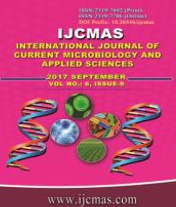


 National Academy of Agricultural Sciences (NAAS)
National Academy of Agricultural Sciences (NAAS)

|
PRINT ISSN : 2319-7692
Online ISSN : 2319-7706 Issues : 12 per year Publisher : Excellent Publishers Email : editorijcmas@gmail.com / submit@ijcmas.com Editor-in-chief: Dr.M.Prakash Index Copernicus ICV 2018: 95.39 NAAS RATING 2020: 5.38 |
The present investigation entitled “Efficacy of certain chemical insecticides against leaf folder, Cnaphalocrocis medinalis Guenee.” was conducted during July, 2015 at Agricultural research farm, SHIATS, Allahabad. The occurrence of leaf folder commenced from 33rd standard week (August 2nd week) with an average 1.54 % infestation. The leaf folder infestation increased and gradually reached peak level of 7.62 % infestation at 38th standard week (September 3rd week). Thereafter, declined trend was observed due to fall of maximum and minimum temperatures as optimum weather condition are decreasing. Therefore, Per cent infestation was positively correlated with the maximum temperature. Hence decline of temperature lead to the decline of the leaf folder infestation. The two sprays were taken for the management of leaf folder. The data on the percent infestation of leaf folder after first and second spray revealed that all the chemical treatments were significantly superior over control. Among all the treatments lowest per cent infestation of leaf folder was recorded in Monocrotophos (1.07) followed by Dimethoate (1.39), Fipronil (1.46), Imidacloprid (1.56), Malathion (1.80), Cartap hydrochloride (1.88), Spinosad (2.28) as compared to control (6.49). At pooled data all the treatments were at par with each other except control, but within this first four treatments i.e. Monocrotophos, Dimethoate, Fipronil and Imidacloprid were best superior treatments in the management of rice leaf folder. The yields among the treatment were significant. The highest yield was recorded in T1 Monocrotophos (43.500 q/ha) followed by T6 Imidacloprid (42.500 q/ha), T7 Dimethoat (40.400) T2 Spinosad (39.800), T5 Fipronil (39.600 q/ha), T3 Malathion (38.20 q/ha), T4 Cartap hydrochloride (38.00 q/ha) as compared to control T0 (25.500 q/ha). When cost benefit ratio was worked out, interesting result was achieved. Among the treatment studied, the best and most economical treatment was T1 Monocrotophos (1:3.16), followed by T7 Dimethote (1:2.95), T6 Imidacloprid (1:2.82), T4 Cartap Hydrochloride (1:2.47), T3 Malathion (1:2.75), T2 Spinosad (1:2.38), T5 Fipronil (1:2.31) as compared to control To (1:2.03).
 |
 |
 |
 |
 |